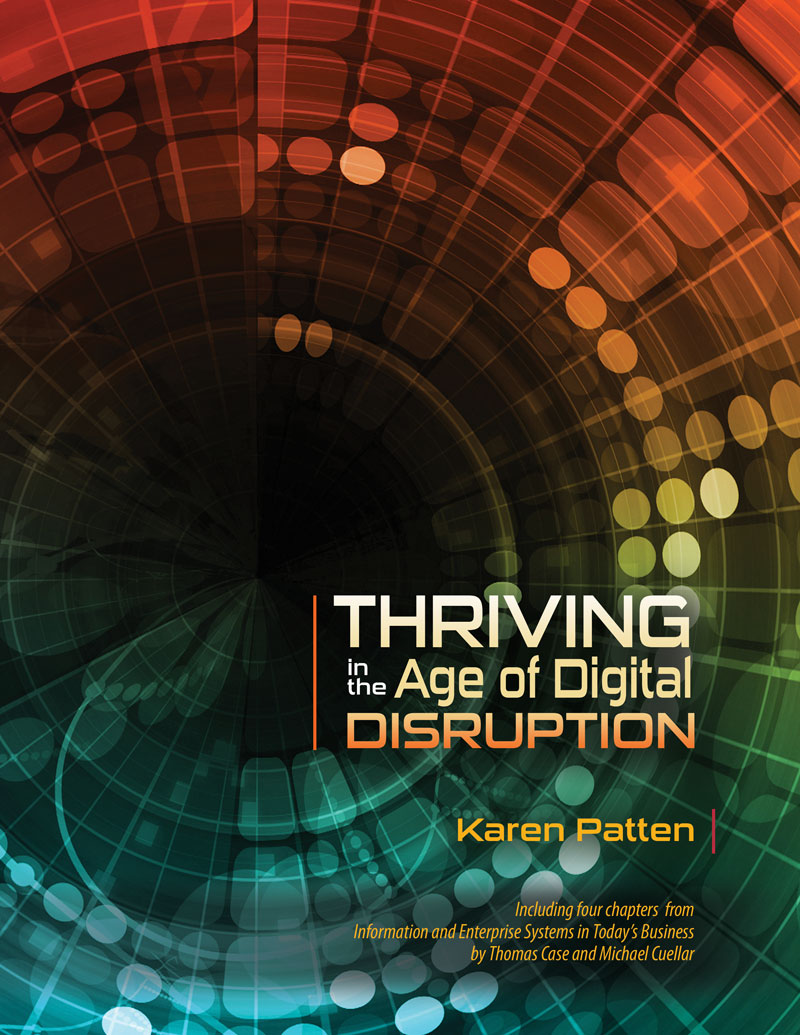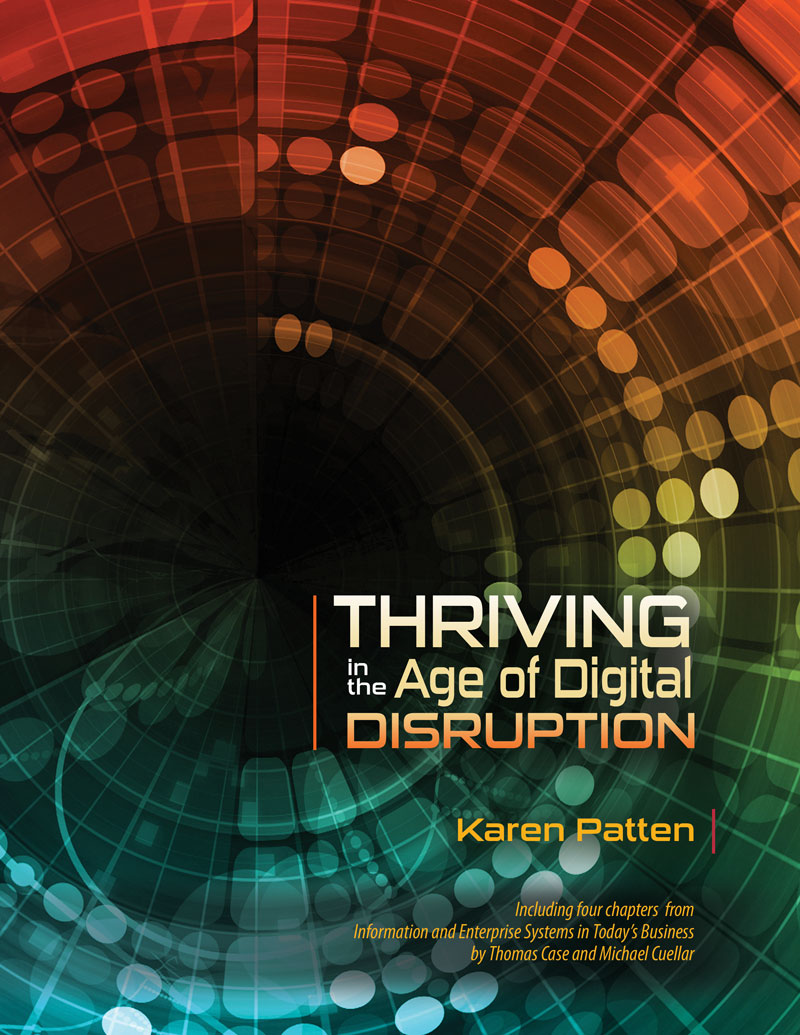Thriving in the Age of Digital Disruption
Author(s): KAREN PATTEN
Edition: 1
Copyright: 2018
Pages: 201
Thriving in the Age of Digital Disruption excites information technology (IT) undergraduate majors and minors about the thrills, challenges, and joy of studying IT and perhaps becoming an IT professional. It defines what the role of IT is in business, its impact on the global economy, the myriad of IT positions, and how it is always changing.
Thriving in the Age of Digital Disruption:
- teaches how IT impacts everyone in a global economy.
- highlights changing technologies and their impacts on business.
Introduction
What is the Purpose of this Book?
Thriving in the Tech Age: An Introductory IT Course for all Undergraduates
What is Included in the Course?
Chapter 1 The Competitive Landscape: What the World is Like in Which You Will Operate Your Business
Chapter Objectives
Introduction
Technological Disruption of the Global Business Environment
Globalization
Technological Advancement
Moore’s Law
Nielsen’s Law
Bell’s Law
Metcalfe’s Law
Technology’s Impact on the Global Economic Marketplace
The New Ethical Concerns
About this Course
Summary
Key Terms
Review Questions
Chapter 2 IT Industries, Careers, and Salaries
Chapter Objectives
Introduction
What Industries Use IT?
Location-Based IT—Global Information Systems
Health Information Technology
Finance IT
How Many IT Positions Exist?
What Should an IT Career Plan Include?
Business Analyst
Entry-Level or Junior Business Analyst
Intermediate Business Analyst
Senior Business Analyst
Computer Systems Analyst
Entry-Level Computer Systems Analyst
Intermediate Computer Systems Analyst
Senior Computer Systems Analyst
Database Administrator
Entry-Level DBA Positions
Intermediate DBA
Senior DBA
Information Security Analyst
Entry-Level Information Security Positions
Intermediate Information Security Analyst
Senior Information Security Analyst
How do I Start Researching my Industry and its Careers?
Chapter 3 Using Information Systems to Gain and Maintain Competitive Advantage
Chapter Objectives
Introduction
What is Competitive Advantage?
Creating and Sustaining Competitive Advantage
Understanding Industry Structure
Competitive Forces
Supply Chain Forces.
An Example Analysis
Selecting a Competitive Strategy
Example of the Automobile Industry
Impacts on IS
Work Systems
IS in Achieving Competitive Advantage
Creating or Improving Products
Enabling Processes
Changing the Structure of the Marketplace
Summary
Key Terms
Review Questions
Chapter 4 Disruptive, Convergent, and Emergent Technologies
Chapter Objectives
Introduction
What is an Emergent Technology?
When is an Emergent Technology Disruptive?
What Happens when Technologies Converge?
What are Some of these Emerging Technologies and What is their Impact?
3-D Printing
Artificial Intelligence
The IoT
Geographic Information Systems
Robotics and Drones
Blockchain
Augmented and Virtual Reality
Will your Industry be Disrupted?
Media
Telecom
Consumer Financial Services
Retail
Technology
Other Industries
Let’s Brainstorm
Why is this Important?
Chapter 5 The Computing Arena: What Is the IT Discipline
Chapter Objectives
Introduction
What is Computing?
How did Computing Develop?
What are the Major Academic Disciplines and How do they Differ?
Computer Science
Information Systems
Information Technology
What are the IT Fundamentals?
IT Body of Knowledge
IT Pervasive Themes
What IT Positions need which IT Bodies of Knowledge Skills?
A Module Assignment
Chapter 6 Enterprise IT Management within the Organization
Chapter Objectives
Introduction
Why Manage IT as a Business Within a Business?
What are the Major Components of the EITO?
Governance
People
Technology—IT Infrastructure
Technology—IT Services, Products, Systems, and Applications
What is E-Commerce versus E-Business?
What are Enterprise Social Platforms?
Why Develop Disaster Recovery and BCP?
What are Risks and Rewards of IT Outsourcing?
What are Successful CIO Characteristics?—A Module Assignment
Chapter 7 BIS Infrastructure and Competitive Capability
Chapter Objectives
Introduction
Business Strategy, EA, and BIS Infrastructure
EA Components
Business Architecture
Data/Information Architecture
Application Architecture
Technology Architecture
Security Architecture
Importance of Strategy, Architecture, and Infrastructure Alignment
BIS Infrastructure
Hardware Components
Determinants of Computer Performance
Hardware Trends
Software Components
System Software
Application Software
Commercial Off-The-Shelf (COTS) Software
Custom Software
Horizontal Market Software
Vertical Market Software
Open Source Software
Mobile Apps
Best-of-Breed versus Integrated Software
On-Premises versus Cloud Software Deployment
Software Trends
Data Management Components
Data Management Trends
Telecommunications Components
Telecommunications Trends
BIS and Cloud Computing
BIS Security
Layered Security and Information Assurance
BIS Infrastructure and Business Strategy
Summary
Key Terms
Review Questions
Chapter 8 Enterprise Systems and Integrated Business Processes
Chapter Objectives
Introduction
Why do Businesses Implement ES?
ES Examples
CRM Systems
SCM Systems
SRM Systems
ERP Systems
ES Ecosystems
Enterprise Systems Architecture
ERP Architecture and Infrastructure
ERP Three-Tier Architectures
ERP Infrastructures
ERP Instances
ERP System Landscapes
ERP and Integrated Business Processes
CRM and ERP Integration
SRM and ERP Integration
SCM and ERP Integration
ERP Selection, Implemention, Upgrade, and Support
ERP Vendor Reputation and Situation
Technologies included in the ERP Vendor’s Solution
ERP Functionalities and Ease of Use
ERP Product Costs and Return on Investment
Available Training and Support for the ERP Product
ERP Vendor Selection Process Phases
ERP Implementation Challenges and Issues
Top Management Commitment
Reengineering Business Process
Integration with BIS Applications
ERP Consultants
Selecting Employees
Employee Training
ERP Implementation Strategies
ES Management and Governance
Enterprise Data Management
Master Data Management
ES and Business Transformation
Summary
Key Terms
Review Questions
Chapter 9 The Unique Role of Ethics in IT
Chapter Objectives
Introduction
Why Study Ethics as Part of IT?
Why is Professional Practice Important for IT Students?
What is the PMI’s Code of Conduct?
Responsibility
Respect
Fairness
Honesty
What is the AITP’s Code of Conduct?
What are the Examples of IT Ethical Challenges?
What is PAPA and How Does It Affect IT?
Conclusion and Wrap-Up
What are Examples of Values, Ethics, and Social Responsibility Challenges and Issues? A Small Team Debate Assignment
Values, Ethics, and Social Responsibility (VESR)
Challenges and Issues—A Small Team Debate Assignment
Purpose of the Assignment
Schedule
Ethics Debate Topics
Thriving in the Age of Digital Disruption excites information technology (IT) undergraduate majors and minors about the thrills, challenges, and joy of studying IT and perhaps becoming an IT professional. It defines what the role of IT is in business, its impact on the global economy, the myriad of IT positions, and how it is always changing.
Thriving in the Age of Digital Disruption:
- teaches how IT impacts everyone in a global economy.
- highlights changing technologies and their impacts on business.
Introduction
What is the Purpose of this Book?
Thriving in the Tech Age: An Introductory IT Course for all Undergraduates
What is Included in the Course?
Chapter 1 The Competitive Landscape: What the World is Like in Which You Will Operate Your Business
Chapter Objectives
Introduction
Technological Disruption of the Global Business Environment
Globalization
Technological Advancement
Moore’s Law
Nielsen’s Law
Bell’s Law
Metcalfe’s Law
Technology’s Impact on the Global Economic Marketplace
The New Ethical Concerns
About this Course
Summary
Key Terms
Review Questions
Chapter 2 IT Industries, Careers, and Salaries
Chapter Objectives
Introduction
What Industries Use IT?
Location-Based IT—Global Information Systems
Health Information Technology
Finance IT
How Many IT Positions Exist?
What Should an IT Career Plan Include?
Business Analyst
Entry-Level or Junior Business Analyst
Intermediate Business Analyst
Senior Business Analyst
Computer Systems Analyst
Entry-Level Computer Systems Analyst
Intermediate Computer Systems Analyst
Senior Computer Systems Analyst
Database Administrator
Entry-Level DBA Positions
Intermediate DBA
Senior DBA
Information Security Analyst
Entry-Level Information Security Positions
Intermediate Information Security Analyst
Senior Information Security Analyst
How do I Start Researching my Industry and its Careers?
Chapter 3 Using Information Systems to Gain and Maintain Competitive Advantage
Chapter Objectives
Introduction
What is Competitive Advantage?
Creating and Sustaining Competitive Advantage
Understanding Industry Structure
Competitive Forces
Supply Chain Forces.
An Example Analysis
Selecting a Competitive Strategy
Example of the Automobile Industry
Impacts on IS
Work Systems
IS in Achieving Competitive Advantage
Creating or Improving Products
Enabling Processes
Changing the Structure of the Marketplace
Summary
Key Terms
Review Questions
Chapter 4 Disruptive, Convergent, and Emergent Technologies
Chapter Objectives
Introduction
What is an Emergent Technology?
When is an Emergent Technology Disruptive?
What Happens when Technologies Converge?
What are Some of these Emerging Technologies and What is their Impact?
3-D Printing
Artificial Intelligence
The IoT
Geographic Information Systems
Robotics and Drones
Blockchain
Augmented and Virtual Reality
Will your Industry be Disrupted?
Media
Telecom
Consumer Financial Services
Retail
Technology
Other Industries
Let’s Brainstorm
Why is this Important?
Chapter 5 The Computing Arena: What Is the IT Discipline
Chapter Objectives
Introduction
What is Computing?
How did Computing Develop?
What are the Major Academic Disciplines and How do they Differ?
Computer Science
Information Systems
Information Technology
What are the IT Fundamentals?
IT Body of Knowledge
IT Pervasive Themes
What IT Positions need which IT Bodies of Knowledge Skills?
A Module Assignment
Chapter 6 Enterprise IT Management within the Organization
Chapter Objectives
Introduction
Why Manage IT as a Business Within a Business?
What are the Major Components of the EITO?
Governance
People
Technology—IT Infrastructure
Technology—IT Services, Products, Systems, and Applications
What is E-Commerce versus E-Business?
What are Enterprise Social Platforms?
Why Develop Disaster Recovery and BCP?
What are Risks and Rewards of IT Outsourcing?
What are Successful CIO Characteristics?—A Module Assignment
Chapter 7 BIS Infrastructure and Competitive Capability
Chapter Objectives
Introduction
Business Strategy, EA, and BIS Infrastructure
EA Components
Business Architecture
Data/Information Architecture
Application Architecture
Technology Architecture
Security Architecture
Importance of Strategy, Architecture, and Infrastructure Alignment
BIS Infrastructure
Hardware Components
Determinants of Computer Performance
Hardware Trends
Software Components
System Software
Application Software
Commercial Off-The-Shelf (COTS) Software
Custom Software
Horizontal Market Software
Vertical Market Software
Open Source Software
Mobile Apps
Best-of-Breed versus Integrated Software
On-Premises versus Cloud Software Deployment
Software Trends
Data Management Components
Data Management Trends
Telecommunications Components
Telecommunications Trends
BIS and Cloud Computing
BIS Security
Layered Security and Information Assurance
BIS Infrastructure and Business Strategy
Summary
Key Terms
Review Questions
Chapter 8 Enterprise Systems and Integrated Business Processes
Chapter Objectives
Introduction
Why do Businesses Implement ES?
ES Examples
CRM Systems
SCM Systems
SRM Systems
ERP Systems
ES Ecosystems
Enterprise Systems Architecture
ERP Architecture and Infrastructure
ERP Three-Tier Architectures
ERP Infrastructures
ERP Instances
ERP System Landscapes
ERP and Integrated Business Processes
CRM and ERP Integration
SRM and ERP Integration
SCM and ERP Integration
ERP Selection, Implemention, Upgrade, and Support
ERP Vendor Reputation and Situation
Technologies included in the ERP Vendor’s Solution
ERP Functionalities and Ease of Use
ERP Product Costs and Return on Investment
Available Training and Support for the ERP Product
ERP Vendor Selection Process Phases
ERP Implementation Challenges and Issues
Top Management Commitment
Reengineering Business Process
Integration with BIS Applications
ERP Consultants
Selecting Employees
Employee Training
ERP Implementation Strategies
ES Management and Governance
Enterprise Data Management
Master Data Management
ES and Business Transformation
Summary
Key Terms
Review Questions
Chapter 9 The Unique Role of Ethics in IT
Chapter Objectives
Introduction
Why Study Ethics as Part of IT?
Why is Professional Practice Important for IT Students?
What is the PMI’s Code of Conduct?
Responsibility
Respect
Fairness
Honesty
What is the AITP’s Code of Conduct?
What are the Examples of IT Ethical Challenges?
What is PAPA and How Does It Affect IT?
Conclusion and Wrap-Up
What are Examples of Values, Ethics, and Social Responsibility Challenges and Issues? A Small Team Debate Assignment
Values, Ethics, and Social Responsibility (VESR)
Challenges and Issues—A Small Team Debate Assignment
Purpose of the Assignment
Schedule
Ethics Debate Topics

